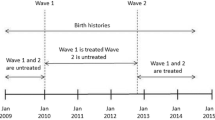Abstract
Objectives: To determine if the quality of prenatal care predicts skilled institutional delivery, a primary means of reducing maternal mortality. Methods: The probability of skilled institutional delivery is predicted among 4173 rural low-income women of reproductive age in seven Mexican states, as a function of maternal retrospective reports about prenatal care services received in 1997–2003. Results: Women who received most prenatal care procedures were more likely to have a skilled institutional delivery (OR 2.29, 95% CI 1.18, 4.44). Women who received less than the 75th percentile of prenatal care procedures were not significantly different from those who received no prenatal care. Conclusions: Policies promoting increased access to prenatal services should be linked to the promotion of practice standards to impact health and behavioral outcomes.
Similar content being viewed by others

References
Implementation of the UN Millennium Declaration: report of the UN Secretary General. Report number A/59/282. New York: The United Nations General Assembly 27 August; 2004.
Khan KS, Wojdyla D, Say L, Gulmezoglu AM, Van Look PF. WHO analysis of causes of maternal death: a systematic review. Lancet 2006;367:1066–74.
Maternal Mortality in 2000. Estimates developed by WHO, UNICEF, and UNFPA. Geneva: World Health Organization; 2004.
Antenatal Care in Developing Countries. Promises, achievements, and missed opportunities: an analysis of trends, levels and differentials, 1990–2001. Geneva: World Health Organization; 2003.
Kotelchuck M. The adequacy of prenatal care utilization index: its US distribution and association with low birthweight. Am J Public Health 1994;84(9):1486–9.
Goldani MZ, Barbieri MA, Silva AAM, Bettiol H. Trends in prenatal care use and low birthweight in southeast Brazil. Am J Public Health 2004;Aug 94(8):1366–71.
Kogan MD, Alexander GR, Jack BW, Allen MC. The association between adequacy of prenatal care utilization and subsequent pediatric utilization in the United States. Pediatrics 1998;102(1):25–30.
Stevens-Simon C, Kelly LS, Singer D. Pattern of prenatal care and infant immunization status in a comprehensive adolescent-oriented maternity program. Arch Pediatr Adolesc Med 1996;150:829–33.
Misra DP, Guyer B. Benefits of limitations of prenatal care: from counting visits to measuring content. JAMA 1998;12(129):1661–2.
Villar J, Ba’aqeel H, Piaggio G, Lumbiganon P, Belizan JM, Farnot U, et al. WHO antenatal care randomized control trial for the evaluation of a new model of routine antenatal care. Lancet 2001;357:1551–64.
Villar J, Bergsjo P. Scientific basis for the content of routine antenatal care. I. Philosophy, recent studies, and power to eliminate or alleviate adverse maternal outcomes. Acta Obstet Gynecol Scand 1997;76(1):1–14.
Bergsjo P, Villar J. Scientific basis for the content of routine antenatal care. II. Power to eliminate or alleviate adverse newborn outcomes; some special conditions and examinations. Acta Obstet Gynecol Scand 1997;76(1):15–25.
Kogan MD, Alexander GR, Kotelchuck M, Nagey DA. Relation of the content of prenatal care to the risk of low birth weight. Maternal reports of health behavior advice and initial prenatal care procedures. JAMA 1994;271(17):1340–5.
Peabody J, Gertler PJ, Leibowitz A. The effects of structure and process of medical care on birth outcomes in Jamaica. Health Policy 1998;43:1–13.
Coria-Soto IL, Bobadilla JL, Notzon F. The effectiveness of antenatal care in preventing intrauterine growth retardation and low birth weight due to preterm delivery. Int J Qual Health Care 1996;8:13–20.
Alexander GR, Kotelchuck M. Assessing the role and effectiveness of prenatal care. Public Health Rep 2001;116:306–16.
Bloom SS, Lippeveld T, Wypij D. Does antenatal care make a difference to safe delivery? A study in urban Uttar Pradesh, India. Health Policy Plan 1999;14(1):38–48.
Perez-Cuevas R, Guiscafre H, Romero G, Rodriguez L, Gutierrez GJ. Mothers’ health-seeking behaviour in acute diarrhoea in Tlaxcala, Mexico. Diarrhoeal Dis Res 1996;14(4):260–8.
Arifeen SE, Blum LS, Hoque DME, Chowdhury EK, Khan R, Black RE, Victora CG, Bryce J. Integrated management of childhood illness (IMCI) in Bangladesh: early findings from a cluster-randomised study. Lancet 2004;364(9445):1595–1602.
National health program 2001–2006. The democractization of health in Mexico: toward a universal health system (in Spanish). Mexico City: The Ministry of Health, Government of Mexico; 2001.
Diaz D, Hofbauer H. The public budget and maternal mortality in Mexico. Mexico City: FUNDAR International Budget Project November 4; 2004.
Reyes GH, Sarti E, Montoya Y, Tapia R, Gutierrez G. Urban–rural variations in medical care of children with diarrhea in Mexico (in Spanish). Salud Publ Mex 1996;38(3):157–66.
Bojalil R, Espinosa P, Martinez H, Palafox M, Romero G, Gutierrez G. The quality of private and public primary health care management of children with diarrhea and acute respiratory infections in Tlaxcala, Mexico. Health Policy Plan 1998;13(3):323–31.
Survey to measure the impact of reproductive health of the Oportunidades program. 2003 sample design (in Spanish). Mexico City: The National Population Council February; 2004.
Clinical Procedural Norm 007-SSA2-1993 for prenatal care, delivery, post-partum, and newborns. Mexico City: The Ministry of Health, Government of Mexico; 1993.
Nolan S, Angos P, Cunha A, Muhe L, Qazi S, Simoes E. Quality of care for seriously ill children in less-developed countries. Lancet 2001;357:106–10.
Acknowledgments
Stefano Bertozzi, Paul Gertler, and the reviewers of this journal provided useful comments; the author remains responsible for all errors and omissions. Funding for this research was provided by NIH Fogarty International Center grant number TW006084
Author information
Authors and Affiliations
Corresponding author
Additional information
National Institute of Public Health, Avenue Universidad No. 655
Rights and permissions
About this article
Cite this article
Barber, S. Does the Quality of Prenatal Care Matter in Promoting Skilled Institutional Delivery? A Study in Rural Mexico. Matern Child Health J 10, 419–425 (2006). https://doi.org/10.1007/s10995-006-0079-x
Published:
Issue Date:
DOI: https://doi.org/10.1007/s10995-006-0079-x



